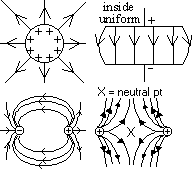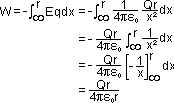ELECTRIC FIELD
Coulomb's law: F bet 2 pt charges Q1 & Q2 is proportional to each of the charge & inversely proportional to dist bet pts

F ∝Q1Q2/r2 => F = kQ1Q2/r2 = F = Q1Q2/(4πε0r2)
k = 1/4πε0, ε0 = permittivity of free space = 8.85 × 10-12C2N-1m-2 (F/m- Farad/metre), εair = 1.0005ε0
electric field = region where electrostatic F is experience by a charge
electric field strength at a pt, E = F per unit +ve charge at pt
-a vector, direction = direction of F
E = F/q (N/C) = Qq/(4πε0r2)(q) = Q/(4πε0r2) [Q: charge of other body]


electric field of sphere w/ charge uniformly distributed on surface
-identical if pt charge at sphere centre, provided r > radius (inside sphere: E diff)
electric field stength
around dipole (dipole: a pair of charges- equal mag, opp signs)
-found by scale drawing
(1)find E due to (i)+ve on test charge, (ii)-ve on test charge
(2)find resultant E at pt

inside charge conductor
-if no current in conductor > no F for electrons to drift > no electric field
inside hollow conductor
-zero charge on inside surface of sphere & zero field within hollow sphere
-charge placed inside hollow conductor immediately flows to outside surface > inside 0 field (important in Van de Graaf generator & Faraday's cage)
electric potential at a pt in an electric field, V = WD in moving unit charge from infinity to the pt (infinity: a pt far away from all other electrical influence)
V = W/q (J/C = V- volt)

E = F/q => F = Eq
W = Fd = Eqd (WD in moving charge against field at const vel)
[if WD in direction of field > -ve work]
W = Eqd => W/q = Ed => V = Ed
E = V/d (for uniform field: pd per unit dist = electric field)
dirn of E = dirn of decreasing potential (high > low, +ve > -ve)
non-uniform field: small charge, q, moves small dist, δx (A > B) > work = δW

since small dist > E ~ const: δW = -qEδx => δV = -Eδx => E = -δV/δx, x → 0, E = -dV/dx
electric potential gradient = electric field strength (dirn of field =
dirn of decreasing potential)

WD by external system in moving δx: δW = -Fδx = -qEδx
WD by external system moving q from ∞ to P:

charge sphere; on surface & inside: E = 0 = -dV/dx => V const

| |
Gravitational |
Electrostatic |
| (inverse square law) |
F ∝ 1/r2 |
F ∝ 1/r2 |
| (F ∝ property) |
F ∝ m |
F ∝ q |
| |
attractive F only |
attractive/ repulsive F |
| potential: |
W/m |
W/q |
| field strength: |
F/m |
F/q |
| |
independent of medium |
depends on medium(εx) |
Back to 'A' level notes index
Back to notes index








